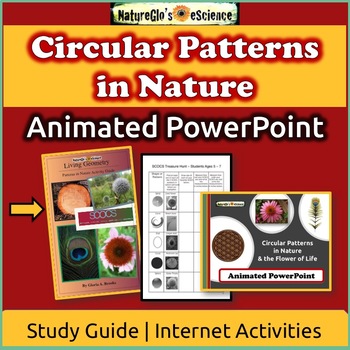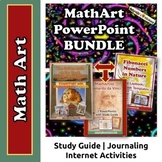Math Art Circular Patterns PowerPoint Thematic Unit Plan | Distance Learning
- Zip
Also included in
- Math With Art is NatureGlo's MathArt Animated PowerPoint BUNDLE with student study guides and Internet Activities! This product is a remarkable growing culmination of 17 years of private school and online homeschool teaching. My homeschool parents tell me that MathArt is the missing link in modern dPrice $155.50Original Price $189.00Save $33.50
Description
This is a perfect all-season mini-unit study with an outdoor treasure hunt. It introduces students of all ages to shapes, patterns, and numbers in nature with an outdoor treasure hunt looking for circular patterns in nature. It is suggested for all ages since most modern education barely touches on patterns found in nature, a branch of Sacred Geometry. Sacred Geometry describes a mathematical order at the heart of the universe. This series incorporates basic math, geometry, writing, art, and ancient history.
Through nature connections outdoors, students learn to appreciate and open their eyes to nature's patterns and apply nature's template in their own artwork, writing, and mathematical thinking. These activities can be adjusted for any type of learning situation and any age group.
What's included:
- 13-slide PowerPoint - introduction to nature's circular patterns including the mysterious Flower of Life design found in ancient art, architecture, and across religions around the world.
- 19-page Activity Guide
- Web resources: projects, activities, videos
The activity guide includes:
- The main outdoor treasure hunt activity
- Nature journal guide with questions
- Varying age-appropriate Venn Diagram handouts
- Large photographs of the author's nature photography of the five SCOCS (spirals, curves, ovals, circles, and spheres) patterns examined.
OTHER TITLES YOU MIGHT LIKE:
PowerPoint & Activity Guide: The Golden Number and Fibonacci PowerPoint
The Golden Ratio & the Great Pyramid Unit Study
LOOKING FOR A FULL YEAR OF MathArt and SCIENCE PLUS SUMMER eLEARNING?
Also Check out:
********************
MathArt Full Year Curriculum (great for grades 3 - 8)
I'd love to stay connected with you! Connect with me now on:
*******************************************************************************
NatureGlo's eScience YouTube Channel
NatureGlo's eScience Pinterest
Got questions? Email me at natureglosescience@gmail.com
Happy learning adventures!
Gloria aka NatureGlo






